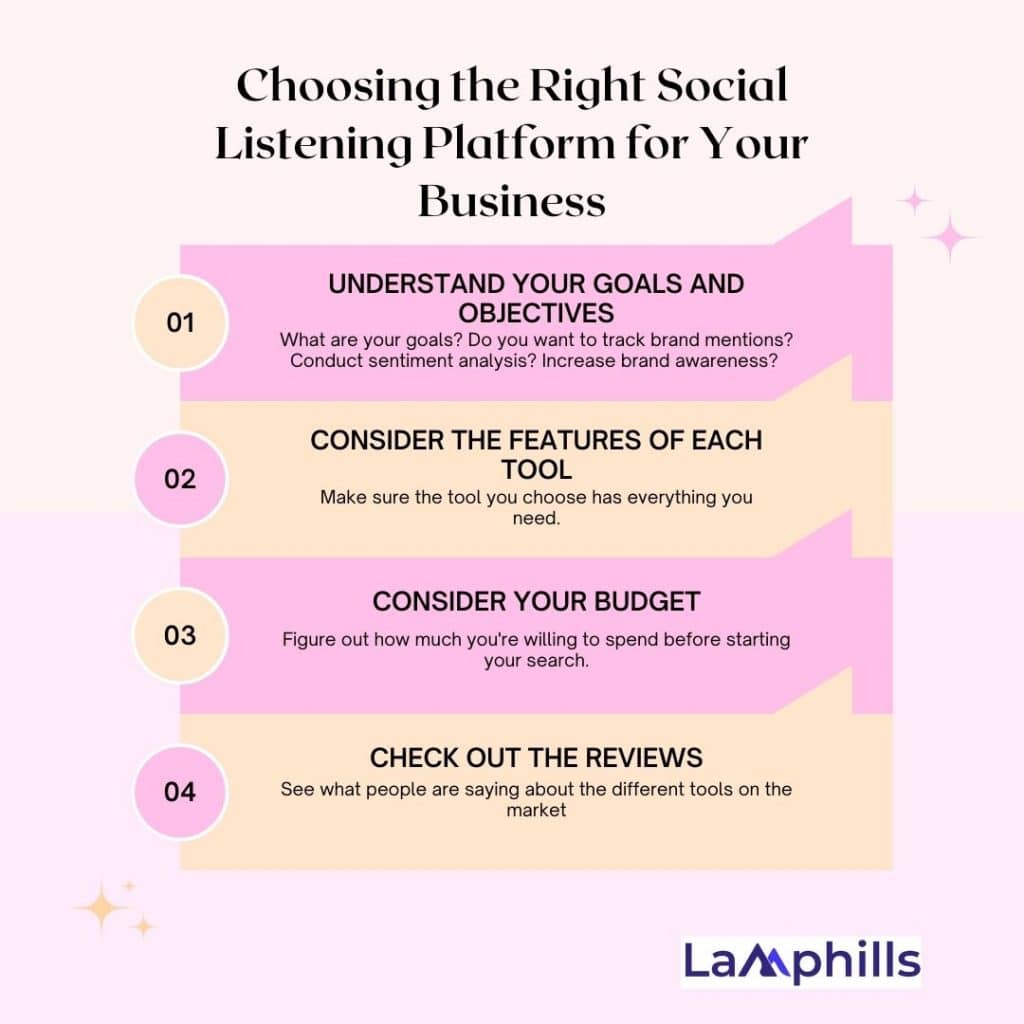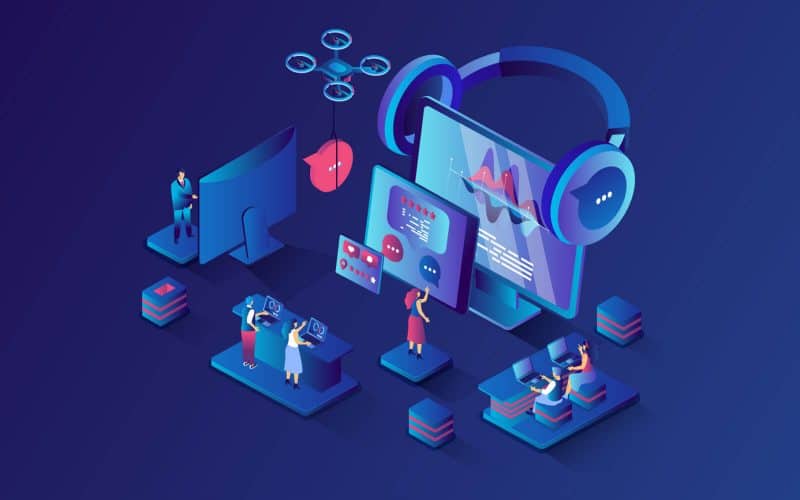I’ve always been fascinated by the evolving ways companies can engage with their customers. From conducting customer and competitor research through focus groups and surveys (which requires a lot of time and money), we’re quickly transitioning to social listening platforms to make the work a lot easier. And if you are still unsure of how to use these platforms or which to choose, I’ve put up a review on some of the best platforms I’ve tested and hope they’ll be beneficial to you.
What are Social Listening Platforms?
Social listening platforms are sophisticated tools that allow businesses to track, analyze, and respond to conversations about their brand on social media and other online channels. Social listening dives deeper than social monitoring, which simply tracks mentions and tags. It analyzes the sentiment behind these mentions and provides actionable insights. This distinction became clear to me when our startup began using social listening. We weren’t just counting mentions; we were understanding the feelings and opinions driving those mentions.
The Importance of Social Listening for Businesses
Social listening has become an indispensable tool for businesses looking to thrive in the digital age. By understanding customer sentiment and feedback, companies can tailor their strategies to meet their audience’s needs. For our startup, social listening revealed that customers were frustrated with our support response times. This insight led us to improve our customer service, resulting in increased customer satisfaction and loyalty.
Identifying trends and opportunities is another critical benefit. During a product launch, social listening helped us detect early signs of a shift in customer preferences, allowing us to adjust our marketing approach. Enhancing customer engagement and loyalty became much easier when we started responding to real-time feedback and making customers feel heard.
Having said that, here are some key reasons to add social listening tools to your social marketing toolbox:
- Understand your brand reputation: In addition to knowing what customers say in posts where they tag you, you can also know what they say when they don’t tag you.
- Creates opportunities for authentic engagement: With social listening tools, you can effectively engage when people mention you on social media platforms.
- Identify pain points and new product opportunities: Social listening tools afford you the opportunity to identify people’s needs and come up with ways to provide solutions and improve the quality of your products or services.
- Track social sentiment in real time: If the conversation about your brand starts to tilt towards negativity, you can take action before things reach crisis level. If something is going unusually well, you can invest in a marketing campaign to keep things running smoothly.
- Identify potential creators to partner with: Social media listening tools help you understand who the big players are in your niche.
- Spot competitor campaigns as they launch. This gives you the chance to analyze potential opportunities and threats just as they start to emerge.
Examples of Popular Social Listening Platforms
There are numerous social listening platforms, each with unique features and strengths. Here are a few that I have personally found invaluable:
#1. Hootsuite Insights
This platform integrates seamlessly with Hootsuite’s social media management tool, providing real-time data and analytics. Its user-friendly interface made it easy for our team to adopt and start using it right away.
#2. Brandwatch
Known for its powerful analytics and detailed reports, Brandwatch helped us dive deep into market trends and customer sentiments. I remember one particular campaign where Brandwatch’s insights helped us pivot our strategy just in time to capture a new trend.
#3. Sprout Social
Sprout Social’s robust reporting tools and ease of use were crucial for our marketing team. Its sentiment analysis feature was particularly useful in understanding customer feedback on new product launches.
#4. Mention
Affordable and effective, Mention is a perfect fit for any startup. It provides real-time alerts and comprehensive analytics, which will help you stay on top of your online presence without breaking the bank.
#5. Talkwalker
Talkwalker’s extensive data coverage and AI-driven analytics gave us a competitive edge. We could track conversations across multiple channels and languages, which was essential as our customer base grew internationally.
#6. NetBase Quid
Netbase’s advanced AI and machine learning capabilities provide deep insights into consumer behavior. It can help you understand broader market trends and competitive landscapes.
#7. BuzzSumo
Ideal for content discovery and performance tracking, BuzzSumo helps you identify what type of content resonates most with your audience. It will play a key role in shaping your content strategy.
#8. Brand24
Brand24 is a powerful tool for measuring brand awareness and reach. It lets you track conversations from 25 million online sources to gather valuable consumer insights. This gives you a better understanding of what people like or dislike, especially when it comes to your brand. You can even measure brand sentiment and quickly identify reputational risks.
#9. Keyhole
Keyhole offers enterprise-grade social listening to gain a deeper understanding of your audience. It provides insights to identify who they are and get a better sense of what they like. You can use the platform to track specific hashtags and keywords as well as identify relevant influencers. The volume predictions feature lets you anticipate when your posts are going viral so you can come up with a game plan.
#10. Meltwater
Meltwater helps you cut through the noise and uncover the conversational insights that matter to your brand. It provides you with a full picture by capturing historical data so you can research changes in trends over time. The platform gives you a better understanding of your audience and allows you to analyze their sentiment. You can use it to monitor brand mentions in real-time and stay on top of upcoming crises to quell them on time.
#11. Awario
Awario is an online monitoring software with analytical and reporting features. The tool monitors Twitter, Facebook, Instagram, Reddit, YouTube, blogs, forums, and news. Unfortunately, it doesn’t provide Telegram or TikTok monitoring.
Awario serves for most important monitoring goals. It will help you grow brand awareness, find sales opportunities, engage with customers on social media, and find influencers.
#12. Buffer
Buffer is a social media management platform. The tool lets you easily schedule social media posts and engage with your audience. It also offers one inbox for all your social media messages.
Buffer works with major social media networks, such as Facebook, Instagram, and Twitter. It also offers an audience behavior unit to help you create better-targeted social media campaigns.
The social media monitoring feature is not available within the core product. To gain access, you need to additionally buy Buffer Reply, which costs $39 per user/month. The monitoring feature only works for Twitter now.
Sprout Social is another social media management tool with a social listening twist. The tool collects mentions of your brand across major social media platforms, such as Twitter, Facebook, Instagram, Reddit, and YouTube.
It offers social media automation to help you manage your online presence and get the insights you need to boost your business.
Sprout Social helps you manage your presence on Facebook, Twitter, Instagram, LinkedIn, and Pinterest. Besides social listening, Sprout Social also offers social media management and publishing services.
Key Features of Effective Social Listening Platforms
To make the most of social listening, it’s important to choose platforms with the right features. Real-time monitoring and alerts keep you updated on the latest conversations about your brand. Sentiment analysis helps you gauge the mood and tone of these conversations. Comprehensive analytics and reporting are essential for making data-driven decisions.
Integration with other business tools, like CRM systems and marketing automation software, ensures seamless workflows. Customizable dashboards allow you to focus on the metrics that matter most to your business. I recall customizing our dashboards to track specific keywords related to our industry, which provided invaluable insights into emerging trends.
How to Choose the Right Social Listening Platform for Your Business

Choosing the right platform starts with assessing your business needs and goals. For us, budget was a significant consideration, so we opted for Mention initially. Evaluating platform features and ease of use is crucial. Some platforms offer extensive features that might be overwhelming for small teams. Reading reviews and seeking recommendations from industry peers can provide valuable insights. Many platforms offer trial periods or demos, which are great for testing the waters before committing. In a nutshell, here are some factors to consider when choosing a social listening platform:
#1. Understand your goals and objectives
What are your goals? Do you want to track brand mentions? Conduct sentiment analysis? Increase brand awareness? Once you know what you need the tool for, you can narrow down your options. Also, check the sources the tool monitors.
#2. Consider the features of each tool
Some tools will have more robust features than others. Make sure the tool you choose has everything you need.
#3. Consider your budget
Yeah, that’s a crucial factor. Tools can range from free (e.g., Tweetdeck) to hundreds of dollars per month (e.g., Brandwatch). Figure out how much you’re willing to spend before starting your search. Luckily, there are plenty of affordable options on the market. You’ll definitely find a tool that meets your needs without breaking the bank.
#4. Check out the reviews
See what people are saying about the different tools on the market. To get an unbiased opinion before making your choice, check software review sites like G2 and Capterra.
Best Practices for Using Social Listening Platforms
Successfully leveraging social listening platforms requires a strategic approach and a commitment to integrating insights into your overall business operations. Here are some best practices that I’ve found invaluable:
#1. Setting Clear Objectives
The foundation of any effective social listening strategy is setting clear, measurable objectives. Without defined goals, it’s easy to get lost in the vast sea of data. When we started using social listening, our primary objectives included improving customer satisfaction, identifying emerging trends, and enhancing our content strategy. By focusing on these goals, we could tailor our efforts and measure our success effectively. Whether you aim to boost customer engagement, manage your brand’s reputation, or inform product development, having clear objectives will align your social listening efforts with your broader business goals.
#2. Regularly Reviewing and Analyzing Data
Data without analysis is just noise. Regularly reviewing and analyzing the data collected from social listening platforms helps you stay informed about what’s being said about your brand and industry. For us, this meant setting up a routine schedule for data review. Weekly reports helped us track ongoing trends, while monthly deep dives provided insights into broader patterns and shifts in customer sentiment. By continuously analyzing data, we could adapt our strategies in real time and remain proactive rather than reactive.
#3. Responding to Customer Feedback Promptly
One of the most powerful aspects of social listening is the ability to respond to customer feedback quickly. Timely responses not only demonstrate that you value your customers’ opinions but also build trust and loyalty. In our experience, addressing customer concerns or acknowledging positive feedback in real-time led to a noticeable increase in customer satisfaction. We implemented a system where our customer service team was alerted to significant mentions, enabling them to respond promptly and appropriately.
#4. Integrating Insights into Business Strategies
Social listening provides valuable insights that can drive various aspects of your business strategy, from marketing to product development. For instance, we noticed recurring mentions of a particular feature that customers wanted. This feedback directly influenced our product development roadmap, ensuring we were meeting our customers’ needs. Additionally, trends identified through social listening informed our content strategy, helping us create relevant and engaging content that resonated with our audience.
#5. Training Your Team
A tool is only as effective as the person using it. Ensuring that your team is well-trained in using social listening platforms is crucial. We conducted several training sessions to ensure everyone was comfortable navigating the platform, setting up alerts, and interpreting the data. This training covered everything from basic platform functions to advanced analytical techniques. As a result, our team was empowered to utilize the platform to its full potential, making more informed decisions based on the insights gathered.
#6. Segmenting Your Data
Not all data is created equal. Segmenting your data by categories such as demographics, geography, and sentiment can provide more targeted insights. We found that segmenting data allowed us to tailor our responses and strategies to specific customer groups. For example, understanding regional differences in sentiment helped us craft more personalized marketing messages that resonated better with local audiences.
#7. Creating a Response Plan
Having a clear response plan in place ensures that your team knows how to handle various types of feedback, from praise to complaints to crises. We developed a response protocol that included guidelines on tone, response times, and escalation procedures. This plan ensured consistency and efficiency in our interactions with customers, enhancing our brand’s reputation and reliability.
#8. Leveraging Advanced Features
Most social listening platforms come with advanced features such as sentiment analysis, trend identification, and competitive benchmarking. Leveraging these features can provide deeper insights and a competitive edge. In our case, using sentiment analysis helped us gauge the emotional tone of conversations, enabling us to address negative sentiments proactively. Trend identification tools highlighted emerging topics and discussions, allowing us to stay ahead of the curve.
#9. Continuously Improving Your Approach
Social listening is not a set-it-and-forget-it strategy. It requires continuous improvement and adaptation. Regularly assess the effectiveness of your social listening efforts and make necessary adjustments. We held quarterly reviews to evaluate our strategy’s impact and identify areas for improvement. This iterative process helped us refine our approach and achieve better results over time.
Common Challenges and How to Overcome Them
One of the biggest challenges we faced was managing the volume of data. It’s easy to get overwhelmed, but focusing on the most relevant metrics helps. Ensuring data accuracy and relevance is another challenge. We developed a system to regularly clean and update our keyword lists. Avoiding information overload involved setting up filters and alerts to catch only the most critical mentions. Maintaining customer privacy and data security is paramount, so we made sure to comply with all relevant regulations and best practices.
The Future of Social Listening Platforms
The future of social listening is exciting, with emerging trends like AI and machine learning enhancing the capabilities of these platforms. The role of big data in social listening is becoming more prominent, providing deeper insights and more accurate predictions. Over the next few years, I anticipate that social listening will become even more integrated with other business tools, offering a more holistic view of customer engagement and market trends.
Is There A Free Social Listening Tool?
Yes, there are free social listening tools available. One popular option is Google Alerts, which tracks mentions of your specified keywords across the web. Hootsuite offers limited free social listening features, and TweetDeck is great for monitoring Twitter conversations for free.
Is Social Listening Worth It?
Absolutely, social listening is worth it. It provides invaluable insights into customer sentiment, identifies trends, enhances engagement, and informs strategic decisions. By understanding and responding to your audience in real-time, you can improve customer satisfaction, loyalty, and overall business performance.
In Conclusion
Social listening platforms have transformed the way businesses interact with their customers and understand market dynamics. From my experience, the long-term benefits of investing in social listening are immense, from improved customer satisfaction to more effective marketing strategies. If you haven’t already, I encourage you to start leveraging social listening platforms to drive your business growth.
I’d love to hear your experiences with social listening platforms. What challenges have you faced, and what successes have you achieved? Share your stories in the comments below, and don’t forget to subscribe to our blog for more insights on digital marketing and business growth.
Related Articles
- Social Listening vs Social Monitoring: The Biggest Differences Explained
- What is Brand Monitoring, and Why Is It Important For Your Business?
- Social Media Etiquette: Best Practices
- Top 51 Social Listening Agencies & All You Need





